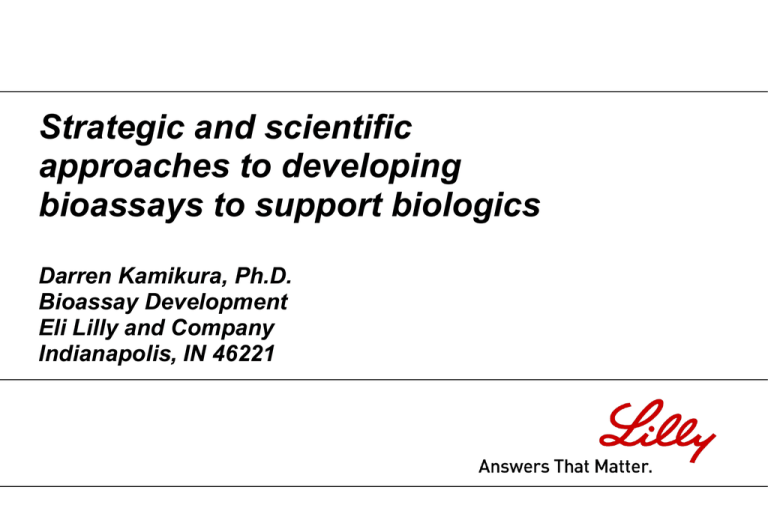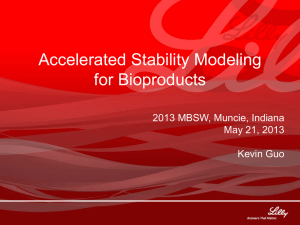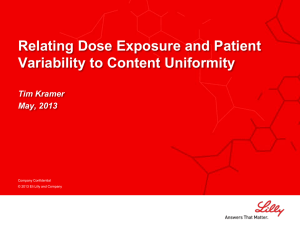BRG Presentation Template
advertisement

Strategic and scientific approaches to developing bioassays to support biologics Darren Kamikura, Ph.D. Bioassay Development Eli Lilly and Company Indianapolis, IN 46221 Why do we care about Potency? For starters…it’s the law!!! PHS Act: 42USC262 (B) The Secretary shall approve a biologics license application -(i) on the basis of a demonstration that -(I) the biological product that is the subject of the application is safe, pure, and potent; 21CFR601.2 To obtain a biologics license …the manufacturer…shall submit data…which demonstrate that the manufactured product meets prescribed requirements of safety, purity, and potency… Adapted from Susan Kirchner (FDA)-USP-Bioassay Workshop 2008 Kamikura MBSW 2012 Company Confidential Copyright © 2012 Eli Lilly and Company What is potency? Potency: 21CFR600.3(s) “The word potency is interpreted to mean the specific ability or capacity of the product(…) to effect a given result.” • Potency is a measure of the ability of a drug to elicit its function. If that ability is to induce (or abrogate) a biological response, then a potency assay should be a bioassay. Kamikura MBSW 2012 Company Confidential Copyright © 2012 Eli Lilly and Company What is a Bioassay? • A bioassay is defined as an analytical procedure measuring a biological activity of a test substance based on a specific, functional, biological response of a test system. • (WHO/NIBSC, J. Immunol. Methods (1998), 216, 103-116. International consensus, Dev. Biol. Standard. (1999) vol 97) Kamikura MBSW 2012 Company Confidential Copyright © 2012 Eli Lilly and Company Why do we need Bioassays? • Biologics are complex and heterogeneous in composition and can exist in a number of physical and chemical conformations that can impact product safety and efficacy (eg. glycosylation, deamidation, conformational changes, polymer). • By measuring the potency, we can infer the ‘structural integrity’ of complex biologicals. Thus, bioassays are a measure of ‘quality’ of the therapeutic. • ICH Q6B (Specifications: Test Procedures and acceptance criteria for Biotechnological/Biological Products) Kamikura MBSW 2012 Company Confidential Copyright © 2012 Eli Lilly and Company What a Bioassay can and cannot tell us • A bioassay CAN 1. indicate product quality 2. be relevant to mechanism of action, and give insights into the way a therapeutic functions at a molecular level 3. be reproducible and suitable for use in a QC environment • A bioassay CANNOT directly predict clinical efficacy/outcome (eg. Biodistribution, PK, non-specific interactions, anti-drug antibodies, etc) Kamikura MBSW 2012 Company Confidential Copyright © 2012 Eli Lilly and Company Types of Bioassays Quantitative Physiological Relevance •Cell based bioassays can be both quantitative and physiologically relevant Kamikura MBSW 2012 Company Confidential Copyright © 2012 Eli Lilly and Company Cell based assays • Cell based bioassays represent a space between drug composition and the clinic (ie. Part way between “chemistry” and “biology”) Potency assay Kamikura MBSW 2012 Company Confidential Copyright © 2012 Eli Lilly and Company Where do we begin? • Design of a relevant bioassay begins with understanding how a drug affects the target biology • eg. Growth factor/cytokine neutralization by NAb • What are the critical biological pathways and can they be exploited to develop a bioassay? • Acquire the right reagents • choice of cell type relevant to disease • downstream read-out (reporter gene, proliferation, etc) Kamikura MBSW 2012 Company Confidential Copyright © 2012 Eli Lilly and Company Cells are Complex Systems • Cells, being part way between “chemistry and the clinic” are more complex than a defined set of chemicals but less complex than an organism • The cells are the foundation of a cell-based assay cells represent the most critical and difficult to control reagent for bioassay performance (large contributor of assay variability) • Two critical, but difficult to answer questions: 1) Why can cells be difficult to control? 2) What defines “The happy/well behaving cell”? Kamikura MBSW 2012 Company Confidential Copyright © 2012 Eli Lilly and Company Cells are Complex Systems • Human cell • ~23,000 protein coding genes/haploid (~1.5% of genome) • Different proteins perform specific tasks and have different locations, based on that task. • There are many events that culminate in a given response Kamikura and Cooper, Traffic (2006) 7:324 Kamikura MBSW 2012 Company Confidential Copyright © 2012 Eli Lilly and Company Cells are Complex Systems • Decision making at a cellular level is stochastic • Many genes contribute to the probability of a given response in any particular cell (Ansel et al, PLOS Genet (2008) 4:1) Antibiotic Kill curve EC50 = 50% dead •What was different about the cells that survived? •Not antibiotic resistant Kamikura MBSW 2012 Company Confidential Copyright © 2012 Eli Lilly and Company Cells are Complex Systems • The ultimate biological response is also influenced by the metabolic state and health of the cells (-) HGF (+) HGF • How many events go into the decision of these cells to scatter in response to HGF? Kamikura MBSW 2012 Company Confidential Copyright © 2012 Eli Lilly and Company Cell based Bioassays can be sensitive • In an average person ~50 x 1012 cells (clinical trials) • In a cell based assay • ~25 x 103 cells/well (2 billion times less cells) • EC50s can be in the range of pg/mL (10-10 - 10-12 g/mL)! • for an antibody (150kDa), 1pg/mL is ~600 molecules/uL • in 100uL, this is ~ 60000 molecules! • just a few molecules are enough to perform the function Kamikura MBSW 2012 Company Confidential Copyright © 2012 Eli Lilly and Company Cell based Bioassays • High sensitivity allows us to detect how various species present contribute to activity and product quality • glycosylation • deamidation • clipping • But… it also means that slight differences or modifications in assay set-up can affect the performance of the assay. Kamikura MBSW 2012 Company Confidential Copyright © 2012 Eli Lilly and Company Generic Bioassay Protocol – Manipulations and Considerations 1. Add Target cells to plate (Numbers?) • Rinse, trypsinize, resuspend, count, dilute, add to plate (6-7 steps) 2. Pre-incubate cells at 37°C (Time?) • Plate position in incubator/heating effects 3. Add Ligand/Antibody/other biologic dilutions (Range?) • Each dilution step is an independent manipulation (8-11 steps for each dilution series) 4. Incubate at 37°C (Time?) 5. Add detection reagents 6. Read in a luminometer How do we know which factors are critical? Kamikura MBSW 2012 Company Confidential Copyright © 2012 Eli Lilly and Company Considerations for Assay Optimization Variables to consider include: • temperature (growth, media for seeding & stimulation) • time of cell growth prior to stimulation • time of stimulation • confluence of cells (seeding & stimulation) • ligand incubation time • ligand concentration • Therapeutic dilution curve • Brand of 96-well plates • Plate sealers/evaporation controls • Media composition (FBS, Defined Media, antibiotics, etc) • eg. Cells may require FBS for survival, but FBS may interfere with the assay outcome. • Plate Layout Kamikura MBSW 2012 Company Confidential Copyright © 2012 Eli Lilly and Company DoE: Consult your local statistician • Optimizing each variable independently and one at a time is inefficient • Effects of some of the variables may not be mutually exclusive. Single factor optimization will not lead to truly optimal conditions • Make friends with your local statistician for success! Kamikura MBSW 2012 Company Confidential Copyright © 2012 Eli Lilly and Company Qualification/Validation of a Bioassay: A critical role for statisticians Post Development: Demonstration of method accuracy, repeatability, intermediate precision, linearity, range and specificity (optional: reproducibility) Early phase qualification is less rigorous • Meet release specifications of 50%-150% relative potency • Demonstration of stability indication via forced/thermally degraded reference standard Late phase validation is much more rigorous • Meet tighter release specifications (eg., 80%-120% relative potency) • Use of multiple DS and DP lots • Capable for assessing primary degradation pathway • Demonstrate in-use sample stability Kamikura MBSW 2012 Company Confidential Copyright © 2012 Eli Lilly and Company Qualification design: 9 total plates Plate # Assay #/Set/Day Analyst Experiment (UNK1, UNK2, UNK3) UNK1 %RP UNK2 %RP UNK3 %RP 1 1 A 50%, 100%, 150% 52.3 101.5 160.5 2 2 B 50%, 100%, 150% 48.6 91.1 127.9 3 1 A 50%, 100%, 150% 55.6 101.6 174.7 4 2 B 70%, 100%, 130% 68.4 90.3 105.7 5 1 A 70%, 100%, 130% 82.0 106.6 142.5 6 2 B 100%, Specificity (alternative molecule 1), control 87.4 ND 70.6 100%, Specificity (alternative molecule 2), control 95.9 ND 76.1 100%, Interference (heat-killed), Interference (Spike) 100.9 ND 94.4 100%, control 100.6 75.7 88.4 7 8 9 Kamikura MBSW 2012 3 3 3 A, B, or C A, B, or C A, B, or C Company Confidential Copyright © 2012 Eli Lilly and Company Validation design: >100 plates Example Drug Substance Experimental Design Validation Study Analyst A B A 50% 75% 100% 125% 150% L, A, I, R, P 3 plates1,2,5 3 plates1 3 plates1,2,3,4,5 3 plates1 3 plates1,2,5 A, I, R 3 plates2 3 plates2,3,4 3 plates2 A, I, R 3 plates2 3 plates2,3,4 3 plates2 B A, I, R 3 plates2,3,4 A A, I, R 3 plates2,3,4 B A, I, R 3 plates2,3,4 Example Drug Product Experimental Design Analyst Validation Study 50% 75% 100% 125% 150% 3 plates1 3 plates1,2,3,4,5 3 plates1 3 plates1,2,5 B L, A, I, R, P 3 plates1,2,5 A A, I, R 3 plates2 3 plates2,3,4 3 plates2 B A, I, R 3 plates2 3 plates2,3,4 3 plates2 A A, I, R 3 plates2,3,4 B A, I, R 3 plates2,3,4 A A, I, R 3 plates2,3,4 L = Linearity1, A = Accuracy2, I = Intermediate Precision3, R = Reproducibility4, P = Repeatability Precision5 Kamikura MBSW 2012 Company Confidential Copyright © 2012 Eli Lilly and Company Conclusion • Cell based assays represent a space between chemical assays and the clinic • Biological systems are extremely complex and sensitive to small variations in environment During assay development, statistics are invaluable in being able to identify interacting biological factors that can impact a given readout Post-development, statisticians are critical for the design and analysis of qualification/validations to ensure that an assay is suitable for its intended use Kamikura MBSW 2012 Company Confidential Copyright © 2012 Eli Lilly and Company








